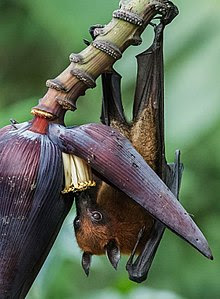 |
| Indian flying fox / Indian fruit bat |
Common Name: Indian flying fox / Indian fruit bat
Scientific Name: Pteropus giganteus
Status: Native
Distribution: South Asia, Southeast Asia, East Asia
Lifespan: 15 - 31.5 years
Lifestyle: Arboreal & Nocturnal
Arboreal locomotion is the locomotion of animals in trees. In habitats in which trees are present, animals have evolved to move in them.
Weight: 600 - 1600 grams
Length: 23 cm
Wing span: 1.2 - 1.5 meters
Diet: Frugivorous, supplementing with insects and flowers with nectar.
A frugivore is an animal that thrives mostly on raw fruits or succulent fruit-like produce of plants such as roots, shoots, nuts, and seeds.
Characteristic features:
- It is called an Indian flying fox since its having a unique fox-like appearance.
- It's having a reddish-brown coat with long snouts as well as large eyes.
- Instead of using echolocation, this flying fox perceives its environment through a well-developed sense of vision and smell.
- It tends to occur near water bodies and roosts among banyan, tamarind and fig trees.
- In order to maintain body temperature, these bats fan themselves with their wings.
Roosting behaviour:
These bats are social and congregatory animals and live in a vertical, male-dominated hierarchy, where High ranked individuals occupy higher spots of the tree, while low-ranked individuals remain in lower spots of the tree.
Congregatory animals tend to gather in large numbers in specific areas as breeding colonies, for feeding, or for resting.
Reproduction:
Mating behaviour: Polygynandrous
Polygynandry is a mating system in which both males and females have multiple mating partners during a breeding season.
Reproduction season: July - October
Pregnancy duration: 140 - 150 days
Baby carrying capacity: 1 - 2 pups
- These are altricial animals. The newborn bats are carried by the mother until 3 weeks old. After pups begin to hang by their feet independently.
Altricial animals are those species whose newly hatched or born young are relatively immobile. They lack hair or down, are not able to obtain food on their own, and must be cared for by adults; Altricial young are born helpless and require care for a length of time.
- At around 11 weeks old, they are able to fly.
- Weaning occurs within 5 months after birth.
- The age of reproductive maturity is 1.5 years old.
Ecological Importance:
- These bats are Zoochory and help the ecosystem by dispersing the seeds.
Zoochory animals are those that can disperse plant seeds in several ways. Seeds can be transported on the outside of vertebrate animals (mostly mammals), a process known as epizoochory. Seed dispersal via ingestion by vertebrate animals (mostly birds and mammals), or endozoochory, is the dispersal mechanism for most tree species.
Reference:
Tags:
Mammals
.jpg)
.jpg)


.jpg)
.jpg)